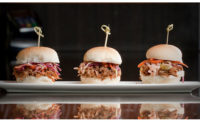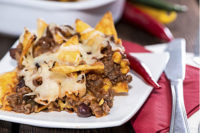Snacking is becoming a way of life for younger consumers, and is affecting menu development and product choices.
For the last few years, menus have reflected this change by redefining appetizers and entrees as starters and mains. The target audience? Millennials and Gen-I, naturally, who prefer grazing on small plate dishes, shareables and snackified entrees with a group.
Their preference for handheld, spicy and snack-style entrees such as street tacos, sliders and loaded nachos are reinvigorating and blending together the snack, side and appetizers segments, and putting the spotlight on protein.
“Since 2014, 42 percent of consumers said their definition of snacking has changed, according to the 2016 Technomic Snacking Consumer Trend Report,” says Patricia Cobe, senior editor of menu analysis at Technomic, based in Chicago. “They consider a wider variety of food and drinks to be snacks. Breaded proteins, mini burgers and chicken strips — or snackified entrees — are the areas growing the most.”
At Au Bon Pan, for example, the restaurant has introduced petite protein plates, says Cobe.
“Some quick service restaurants (QSR) are adding snacks to menus because consumers are seeking them out since snacking is more prevalent,” she says. “Eighty-three percent of consumers snack on a daily basis, up from 76 percent in 2014.”
Since Millennials have more flexible eating patterns, they are more likely to graze all day and add heartier mid-morning or late-night snacks instead of eating three square meals.
“The definition of snacks is broadening to include heartier snacks, and 40 percent of consumers are also eating healthier snacks,” Cobe says.
In addition, top 500 Limited Service Restaurant (LSR) menus are featuring popular mini-entrees billed as snacks, resulting from consumers’ increased snacking frequency, says Cobe.
“Appetizers and desserts are still notably less expensive than entrees, which makes them appealing snack options as well,” Cobe says.
Balancing health with indulgence
Overall, the top growing appetizers are more vegetable-oriented as people look for a healthy touch to kick off their often more indulgent entrees at restaurants.
“Kale salad is the top growing appetizer, followed by quinoa salad and then Brussels sprouts,” says Claire Conaghan, senior account manager, Datassential, based in Chicago. “In general, these categories are areas where meat protein isn’t seen as essential [unlike in entrees where consumers still seek out a center of plate protein often times] and over time consumers are getting more aware of ways in which protein can come from non-animal proteins such as lentils and beans, which we expect to continue to see.”
However, some protein-oriented appetizers are having more success, she says.
“Buffalo chicken dip is now found on 1 percent of appetizer menus and is up more than 200 percent over the past four years,” says Conaghan. “Pork belly is also growing, up 188 percent vs. four years ago — being used in sliders, as a stand-alone appetizer and often paired with Asian flavors. Fish tacos are also growing, up 140 percent over the past four years. And charcuterie, which uses a wide variety of proteins, continues to trend up 132 percent over the past four years.”
Cured proteins, especially bacon, are added to vegetable dishes for a touch of indulgence, Conaghan says.
“Overall dishes that might be a bit much for a whole entree lend themselves well to appetizers, as you see with pork belly,” she says. “Pork belly is a fatty and rich cut that works better in the small quantities found in appetizers.”
Indeed, pork is an essential component of new, spicier dishes.
“Asian cuisine seems to be exerting more influence on the market as consumers are beginning to warm up to cuisine from South Korea, for instance,” says Tom Vierhile, innovation insights director at Canadean, a market research and analysis firm based in Fairport, N.Y. “The Bakkwa product [meat jerky] is one of the more interesting products in the batch because it is said to be inspired by Malaysian street food. Street food in general seems to be a newer source of flavor innovation for products like beef jerky, as well as other types of appetizers.”
Even though pork ties in well with current ethnic trends, it still carries a bit of a negative stereotype because of its sodium content, says Billy Roberts, senior food and drink analyst for Chicago-based Mintel: “Even younger consumers — 32 percent of Millennials, for example — are looking to avoid sodium in healthy foods, compared to 48 percent of Baby Boomers.”
Millennials are more willing to embrace fish, shellfish and other types of fish, which carry the health halo, Roberts says.
Seafood, in fact, is another big driver of new appetizers. “In full-service restaurants, we’re seeing chicken in 12 percent of appetizers and shrimp in 6 percent,” Cobe says.
Chicken is always popular as it’s healthy and can adapt to a variety of flavors and dishes at lower price points. “Chicken cannot be underrated because of its use in diverse dishes like pot stickers and it fits in with a lot of flavor profiles,” Roberts says. “Chicken has a strong selling point, more so than fish.”
Side dishes including fries, mac and cheese and nachos are being upgraded with ground beef, chicken or pulled pork to make them more hearty, Cobe notes.
“In full-service restaurants, chicken is showing up in 16 percent of starters as an ingredient and ground beef is up 20 percent, with much of the increase in nachos, tacos and sliders,” Cobe says.
Sharing snacks
Tying in with the snacking trend, diners are looking for snacks that can double as entrees and/or be shared with others, such as “shareables,” Cobe says.
“Sides are also becoming more shareable as they can double as appetizers like loaded fries and nachos or sampler plates, which are trending up,” Cobe says.
Bar food, for example, is a good source of protein for snacks and shareable appetizers in a casual dining setting.
“In my opinion, street food is a big motivator for menu development, especially at Asian and Mexican restaurants with Asian sautés, Chinese balls with pork or chicken and Mexican street tacos,” Cobe says. “This trend will impact restaurants having more protein on their menu for starters, sides and snacks.”
Ethnic flavor trends continue to be popular as spicy, street foods trend up. According to Technomic’s 2015 Starters, Small Plates and Sides Consumer Trend Report, two-fifths of consumers (ages 18 to 34) say they want more restaurants to offer apps and small plates with ethnic flavors and are more apt to try new flavors or ingredients.
“P.F. Chang is a good example of a restaurant incorporating street foods into its menu, adding more ethnic appetizers and shareables,” Cobe says.
As protein prices continue to fall, this development should lead to more protein being used in snacks and appetizers, especially because consumers perceive protein as a healthy ingredient to eat, she says.
“That being said, there will likely always be a place for a touch of protein in an appetizer as we saw happen with the chopped chicken in a buffalo chicken dip or the touch of bacon or pancetta with Brussels sprouts,” says Conaghan. “We also expect to continue to see high-quality proteins served raw including in crudo dishes (up 110 percent over past four years), poke (up 65 percent over past four years) and tartare (up 65 percent over the past four years).”
Eating on the run
At retail, the hot appetizers are stuffed products and bites, Vierhile says.
“‘Stuffed’ definitely moves the sector in more of an indulgent direction and it is also a value for the money play,” says Vierhile. “Note also how companies are embracing utensil-less dining. The Special K Crustless Quiche is a good example, as it is intended to be eaten like pizza.”
Velveeta’s Stuffed Grilled Cheese bites, Totino’s Stuffed Nachos and Pizza Sticks, Hot Pockets and Jimmy Dean’s Stuffed Hash Browns and Frittatas frozen products are also intended to be handheld, Vierhile says.
“The Jimmy Dean Frittatas product is promoted in stores with signage that says ‘a whole egg breakfast without all of the bread and carbs,’” Vierhile says. “One thing I have noticed just recently in the supermarket is that carb-avoidance seems to be coming out of hibernation. It was big many years ago, but it seems to be moving up on the radar of late.”
As far as the future, the appetizer area will see ongoing innovations as these products are ideally suited for grazing and work as a hot snack or as a quick meal, which is exactly what consumers are requesting.
“This dovetails quite nicely into how eating patterns for Millennial-age consumers are changing,” says Vierhile. “According to a recent PLMA [Private Label Manufacturers Association] Consumer Research study on Americans between the ages of 20 and 29, 49.6 percent say they either ‘strongly agree’ or ‘agree’ that they ‘have no set schedule or times for meals.’ That suggests that we will see a lot of future innovation around food products that can either be consumed as a snack, or a small meal.”
Favoring beef jerky
The $370 billion packaged food market (40 percent of which is snack products) is expected to grow 2 percent a year through 2019 due to Millennials’ snacking habits, reports Euromonitor.
And by wide margins, they say they express interest in protein and consider it to be healthy (68 percent for Millennials and 72 percent for Gen-I), Roberts says.
“However, we’re not seeing a lot of snack launches recently making use of high-protein claims — only 5 to 6 percent,” he says. “So there are real opportunities to grow.”
As the population becomes younger, the snacking trend should only increase because that is how Generation-I and Millennials are used to eating — on the run with handheld foods, Cobe says.
“Proteins can adapt well to being eating on the run,” she says.
Animal protein in snack foods is making somewhat of a comeback, which is driven by a counter movement to the strong trend of vegetarian/vegan eating habits, says Robin Wyers, chief editor, Innova Market Insights, based in Arnhem, Netherlands.
“People might opt for a few meatless days per week but then also choose higher value products in animal protein on the other days,” says Wyers. “Food truck festivals and the burger mania show that animal protein is still popular with consumers — for example, the popularity of pulled pork and barbecued meats is now a trend in foodservice.”
Beef jerky is certainly the protein snack of choice for meat lovers — and Millennials. The NPD Group reported in 2015 that consumers ages 18 to 24 are more likely than other age groups to eat meat snacks during the day. Moreover, beef jerky consumption has also increased 18 percent among adults in the last five years.
“And the trend in meat snacks is toward pork jerky, jerkies based on ‘better’ cuts of meat [such as tri-tip and filet mignon], Asian jerky products, ‘sweet’ jerkies [including Asian-inspired flavors] and even experimentation in game meats,” Vierhile says.
Speaking of game meat, Arby’s launched venison sandwiches in some parts of the country where deer hunting is big in October, and the sandwiches were reportedly a hit, Vierhile says.
“I don’t remember a major restaurant chain embracing game meats to this level before, so maybe we’re nearing an inflection point for this,” Vierhile says.
The meat snacks segment experienced the largest growth of all segments during the review period, notes Vierhile.
“Meat snacks have grown in popularity, as consumers view these as a convenient, tasty and high-protein snack,” says Mintel’s Salty Snacks — US April 2016 report. “These nutrient-dense snacks also fit into several niche diets including gluten-free and Paleo. The segment also benefits from simple ingredients and strong flavor and ingredient innovation from large and niche brands alike.”
Capitalizing on protein
For 2017, Innova predicts “kitchen symphony” will reign. So consumers will take their knowledge of authentic ethnic cuisine and local and regional foods to experiment with new recipes and dishes at home.
“Sushi continues to be popular, but a wide variety of other ethnic foods will make a comeback in convenience party snacks [spring rolls] of which some contain meat,” Wyers says.
Another big trend according to Innova will be the continuing clear-label craze or “clean supreme.”
“Where convenience products with processed meat suffered from a too much processed character, organic and locally or origin-sourced options provide new options on the shelf,” Wyers says.
The future remains bright for protein as it continues to be the hot nutrient, compared to almost anything else.
“According to a Q3 2016 Canadean survey, 38 percent of American consumers say they ‘try to eat as much as possible’ when it comes to protein,” says Vierhile. “That’s better than the 32 percent that say the same for fiber, 29 percent for whole grains, 26 percent for calcium and 20 percent for probiotics.”
Only vegetables (at 43 percent) and fruit (at 42 percent) rank higher on the “eat as much as possible” scale, Vierhile says.
“You wonder at some point if protein’s star may dull a bit as it has become so ubiquitous in the supermarket, but we don’t seem to be at that point yet,” Vierhile says.
As consumers embrace grazing throughout the day and look for easy foods to prepare, protein-based snacks, apps and side dishes will continue to do well, if not grow, Roberts says.
“Brands will do well if they capitalize on protein in general,” says Roberts. “We see protein in frozen dinners, but not in as many frozen snacks or shelf stable snacks as we could.” NP








Report Abusive Comment